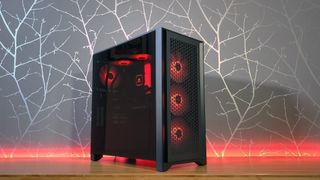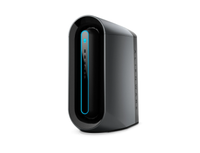The best gaming PCs that have gone through Tom’s Hardware’s labs are pre-builts that impressed.

(Image credit: Tom’s Hardware)
When you’re in the market for a gaming PC, there’s a lot to consider: power, size, components and what resolution you want to play at. (If you’re looking for portability, check out the best gaming laptops.)
If all you need is to play a few AAA titles at 1080p, you won’t need the absolute best GPU and/or best CPUs for gaming on the market.
But if you want to play at 1440p or 4K, then you need to start thinking about saving more for your rig. CPU horsepower is also tied to gaming acumen, but branching out into anything over a quad-core processor will primarily see performance gains in multi-threaded workloads such as video processing, rendering and encoding, not games.
Right now, finding exactly what you want may be difficult due to component shortages. For many, finding a pre-built PC might be the easiest way to get the parts you want.
How to Choose a Gaming PC
- Bigger isn’t always better: You don’t need a huge tower to get a system with high-end components. Only buy a big desktop tower if you like the look of it and want lots of room to install future upgrades.
- Get an SSD if at all possible: This will make your computer far more faster than loading off of a traditional HDD, and has no moving parts. Look for at least a 256GB SSD boot drive, ideally paired with a larger secondary SSD or hard drive for storage.
- You can’t lose with Intel or AMD: As long as you opt for a current-generation chip, both companies offer comparable overall performance. Intel’s CPUs tend to perform a bit better when running games at lower resolutions (1080p and below), while AMD’s Ryzen processors often handle tasks like video editing better, thanks to their extra cores and threads.
- Don’t buy more RAM than you need: 8GB is OK in a pinch, but 16GB is ideal for most users. Serious game streamers and those doing high-end media creation working with large files will want more, but will have to pay a lot for options going as high as 64GB.
- Don’t buy a multi-card gaming rig unless you have to: If you’re a serious gamer, get a system with the best-performing single graphics card you can afford. Many games don’t perform significantly better with two or more cards in Crossfire or SLI, and some perform worse, forcing you to disable an expensive piece of hardware to get the best experience possible. Because of these complications, you should only consider a multi-card desktop if you are after more performance than can be achieved with the best high-end consumer graphics card.
- The power supply is important: Does the PSU offer enough juice to cover the hardware inside? (In most cases, the answer is yes, but there are some exceptions, particularly if you intend to overclock.) Additionally, note if the PSU will offer enough power for future upgrades to GPUs and other components. Case size and expansion options vary drastically between our picks.
- Ports matter: Beyond the connections necessary to plug in your monitor(s), you’ll want plenty of USB ports for plugging in other peripherals and external storage. Front-facing ports are very handy for flash drives, card readers, and other frequently used devices. For added future-proofing, look for a system with USB 3.1 Gen 2 and USB-C ports.

Most pre-built gaming PCs, including those on our list of the best, come in multiple configurations. While we list the ones we reviewed, others may be better for you.
Graphics cards, including Nvidia’s RTX 3090, RTX 3080, and RTX 3070 GPUs, are still hard to get. Some of our Nvidia-based picks still have the last-gen cards, though those who are patient or keep checking back may be able to find them with the latest and greatest.
For most people, budget plays the biggest role in a desktop buying decision. You can sometimes find good deals on big-box desktops when they go on sale, but you’ll be stuck with the components chosen by the likes of HP, Lenovo or Dell. The beauty of a custom-built PC is that you can adjust the component configuration until it suits your needs and budget. We are happy, though, to see more builds coming with standardized parts than ever before, so you can upgrade them later on.
Intel’s Alder Lake CPUs are launching soon, which will likely trigger refreshes for many popular models and possibly some new ones, as well.
Best Gaming PCs You Can Buy Today

The MSI Aegis RS 11th is a top-of-the line pre-built gaming desktop. The 11th Gen Intel Core CPU and options for an RTX 3080 bring awesome gaming performance in a design that you can upgrade yourself down the line.
All of the parts are standardized, including the case. In fact, MSI makes the case, motherboard, CPU cooler, fans, GPU and power supply. This is the type of pre-built that you can upgrade, tinker with and make your own over the next several years.
If you don’t have a keyboard and mouse, the peripherals that MSI includes are decent enough to get started, though you’ll likely want to bump up the keyboard to something with mechanical switches eventually.
Read: MSI Aegis RS 11th review

The Alienware Aurora R11 muscled its way onto our list with its sheer GPU power. Right now, it’s really hard to find one of Nvidia’s Ampere GPUs, but as of this writing Alienware is shipping with both RTX 3080 and RTX 3090, so that’s one way to go.
The design is futuristic, and while it may be divisive to some, you can’t argue that it’s fairly compact. The RTX 3090, compared with the Intel Core i9-10900K in our review unit, offered some top-notch gaming performance. It uses largely standardized parts and has plenty of room for extra drives.
The biggest downside is that the machine gets loud with few case fans. It’s also expensive, but it’s a maxxed out machine, not just the graphics card.
Read: Alienware Aurora R11 review
The Alienware Aurora R11 has been supplanted by the Alienware Aurora R12. We haven’t tested it yet, but if you’re looking for the newest, you may want to try these configurations:

No intense lighting, no glass windows, just a small tower packed with gaming power. The iBuypower Revolt 3 has steel panels, black mesh and a largely subtle design. It’s clever, though, with two headset hangers and a built-in handle to carry it to your next LAN party.
At $2,599 as tested with an Intel Core i7-11700KF and an RTX 3080, it’s not listed at a crazy price considering today’s component shortage. And those components offer excellent performance in this tiny chassis.
Small form factor PCs can bring some oddities. This one has the motherboard I/O on the bottom of the case, so you have to lift it up to plug in or remove peripherals. Additionally, there is limited room in this case for when you want to make upgrades.
We also happen to like this case this system comes in on its own, if you’re looking to build your own PC.
Read: iBuypower Revolt 3 i7BG Review

The Corsair One a200 takes up minimal space on your desk, thanks to its tall, tower shape that crams in components. This desktop has an AMD Ryzen 9 5900X and Nvidia Geforce RTX 3080, both of which are liquid cooled to offer top-end performance. It also came with 32GB of RAM, a 1TB M.2 SSD and a 2.5 TB HDD for more games.
Despite the powerful parts, the computer is largely quiet thanks to an effective cooling system that draws in cool air through the sides to cool the components, and then expels hot air with a fan on the top. This can, however, make the system difficult to upgrade later, as everything is really packed into the 12-liter chassis.
The downside to top-of-the-line components is the price. We tested the Corsair One a200 at $3,799.99.
Read: Corsair One a200 Review
There are two other versions, both of which are Intel-based. There’s an 11th Gen Intel Core Core i9-11900K version for the same price on Corsair’s website and a cheaper $3,599.99 version:

Do you strictly need to spend more than $5,000 on a gaming PC? No, but you can, and you’ll get a luxurious experience. The Maingear Vybe is a gorgeous desktop thanks to options for automotive paint and a minimalistic design. And with its Apex liquid cooling, it’s stunningly quiet.
That’s even when running an overclocked Intel Core i9-10900K at 5.3 GHz. Between that chip and an RTX 2080 Ti, the system provides incredible gaming performance.
One big area you may want to configure differently is our review unit, which used a budget Intel 665P SSD, but you can make this thing to order, including AMD Ryzen options.
If you prefer something a bit smaller that’s still a splurge, the Maingear Turbo has the same build quality, though you can only get it with Ryzen CPUs.
Read: Maingear Vybe review

The Dell G5 is small for a mid-tower, and can play most games at mid or high settings at an affordable price. If you want to get into PC gaming and don’t care to focus on tinkering too much, it’s a good choice, though there are a ton of configuration options.
The G5 also has a lot of ports on the front and on the rear, making it easy to expand with peripherals and external storage. Inside, expansion options include extra room in hard drive cages and m.2 2280 slots.
Read: Dell G5 review
Dell G5 Updated Configuration

It’s been awhile since we reviewed the G5 desktop, though Dell is still using a similar chassis (albeit with optional RGB lighting now). Mid-tier users may want to opt for a current version with a 10th Gen Intel Core i5-10400F, Nvidia GeForce GTX 1660 Ti, 16GB of RAM, a 512GB M.2 SSD for $1,149.99 at Dell, or with an i7-10700F, GTX 1660 Ti, 16GB of RAM and 1TB SSD for $1,349.99 at Best Buy.

The HP Omen 30L is a big-box gaming PC that feels like one you build. The latest design adds more airflow with an intake fan, plus sleek glass front and side panels and still has an easy-access panel to get to the most critical components. Oh, and of course the new intake fan has some sleek RGB to go with the new logo and the rest of the system.
The version we tested, with a 10th Gen Intel Core i9 and an RTX 3080 proved powerful in our gaming benchmarks and productivity tests. We do wish that HP had a more powerful CPU cooler, as the single 120 mm fan isn’t always enough for the Intel Core i9.
The addition of name-brand parts is also nice to see. There’s little, if anything, proprietary about the system, which includes a micro-ATX motherboard, WD Black SSD, Seagate HDD and a 750W power supply. That’s the special sauce that makes it feel a bit more like an enthusiast machine than some alternatives.
Read: HP Omen 30L Review
If you can’t find the model we tested, there are a variety of other options, including some with AMD processors:
Gaming PCs You Can Get During the Component Shortage
Right now, we’re going through a global component shortage, which has made it difficult to buy the best CPUs for gaming, the best GPUs and really anything that goes in a gaming PC at all. In turn, people are turning to buy anything they can, including full-built gaming PCs, even if they only need a few parts. This is especially the case with Nvidia’s RTX graphics cards.
We haven’t been able to review all of these PCs, so shop with caution, but we’re keeping an eye on the market so you can see what may be available since our last update.
$2,000 and more Gaming PCs
| Skytech Chronos Gaming PC | AMD Ryzen 5 5600X / Nvidia GeForce RTX 3070 | See at Amazon |
| Alienware Aurora R12 | Intel Core i9-11900F / Nvidia GeForce RTX 3080 Ti | See at Dell |
$1,000 – $2,000 Gaming PCs
| Alienware Aurora R12 | Intel Core i7-11700F / Nvidia GeForce RTX 3060 Ti | See at Dell |
| Cyberpower PC Gamer Xtreme | Intel Core i7-11700F / Nvidia GeForce RTX 3060 | See at Best Buy |
Under $1,000 Gaming PCs
| Lenovo Legion Tower 5i | Intel Core i5-11400 / Nvidia GeForce GTX 1660 Super | See at Best Buy |
Discounts on the Best Gaming PCs
If you’re looking for a system that’s among our best gaming PCs or something similar, you may find savings by checking out the latest Newegg promo codes, Corsair coupon codes, Dell coupon codes, HP coupon codes, Lenovo coupon codes or Razer promo codes.
MORE: Best Gaming Laptops
MORE: Best PC Builds
Please take a moment to browse our titles and let us know if you have any questions. Thank you, Touchstone Bros.




























